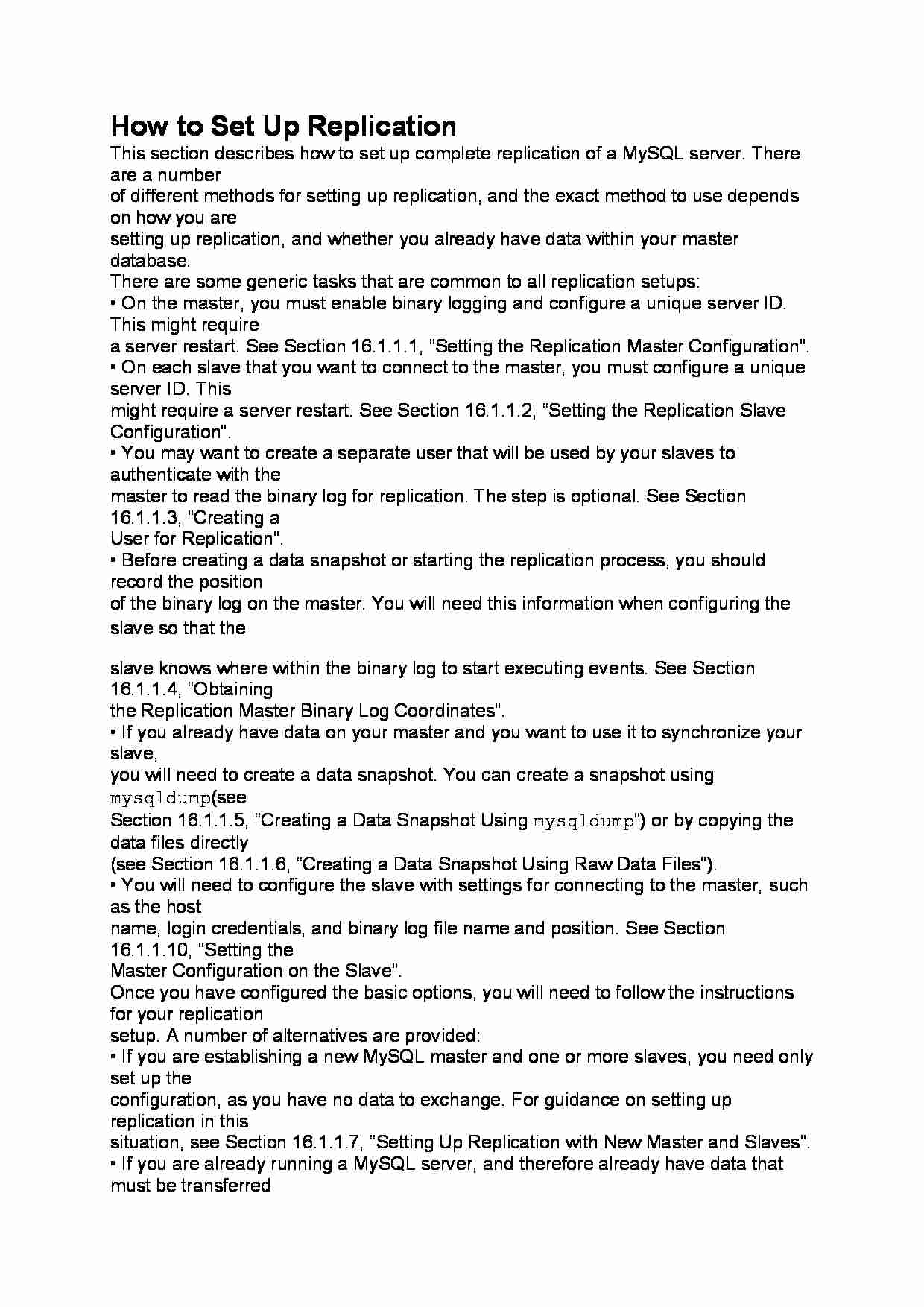To tylko jedna z 2 stron tej notatki. Zaloguj się aby zobaczyć ten dokument.
Zobacz
całą notatkę


How to Set Up Replication
This section describes how to set up complete replication of a MySQL server. There are a number
of different methods for setting up replication, and the exact method to use depends on how you are
setting up replication, and whether you already have data within your master database.
There are some generic tasks that are common to all replication setups:
• On the master, you must enable binary logging and configure a unique server ID. This might require
a server restart. See Section 16.1.1.1, “Setting the Replication Master Configuration”.
• On each slave that you want to connect to the master, you must configure a unique server ID. This
might require a server restart. See Section 16.1.1.2, “Setting the Replication Slave Configuration”.
• You may want to create a separate user that will be used by your slaves to authenticate with the
master to read the binary log for replication. The step is optional. See Section 16.1.1.3, “Creating a
User for Replication”.
• Before creating a data snapshot or starting the replication process, you should record the position
of the binary log on the master. You will need this information when configuring the slave so that the
slave knows where within the binary log to start executing events. See Section 16.1.1.4, “Obtaining
the Replication Master Binary Log Coordinates”.
• If you already have data on your master and you want to use it to synchronize your slave,
you will need to create a data snapshot. You can create a snapshot using mysqldump (see
Section 16.1.1.5, “Creating a Data Snapshot Using mysqldump”) or by copying the data files directly
(see Section 16.1.1.6, “Creating a Data Snapshot Using Raw Data Files”).
• You will need to configure the slave with settings for connecting to the master, such as the host
name, login credentials, and binary log file name and position. See Section 16.1.1.10, “Setting the
Master Configuration on the Slave”.
Once you have configured the basic options, you will need to follow the instructions for your replication
setup. A number of alternatives are provided:
• If you are establishing a new MySQL master and one or more slaves, you need only set up the
configuration, as you have no data to exchange. For guidance on setting up replication in this
situation, see Section 16.1.1.7, “Setting Up Replication with New Master and Slaves”.
• If you are already running a MySQL server, and therefore already have data that must be transferred
to your slaves before replication starts, have not previously configured the binary log and are able to
(…)
… therefore already have data that must be transferred
to your slaves before replication starts, have not previously configured the binary log and are able to
shut down your MySQL server for a short period during the process, see Section 16.1.1.8, “Setting
Up Replication with Existing Data”.
• If you are adding slaves to an existing replication environment, you can set up the slaves without
affecting the master. See Section 16.1.1.9, “Introducing Additional Slaves to an Existing Replication
Environment”.
If you will be administering MySQL replication servers, we suggest that you read this entire chapter
through and try all statements mentioned in Section 13.4.1, “SQL Statements for Controlling Master
Servers”, and Section 13.4.2, “SQL Statements for Controlling Slave Servers”. You should also…
... zobacz całą notatkę




Komentarze użytkowników (0)